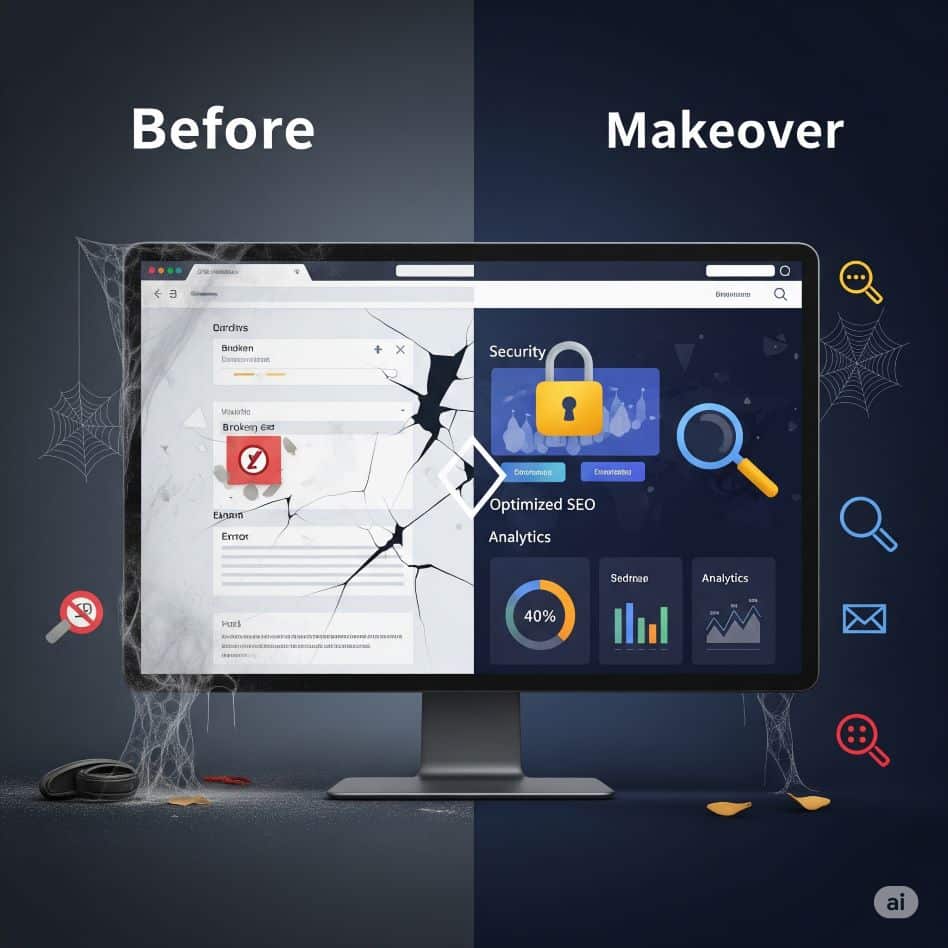
Why Do So Many Small Business Websites Fall Flat? 📉 (And How to Make Yours Soar! 🚀)

It’s a common story: a small business invests in a website, launches it with a flourish, and then… crickets. 🦗 Many small business websites fail to achieve their goals, leaving owners scratching their heads and wondering where they went wrong. The truth is, building a website is just the first step. The real work begins after launch!
Here’s why many small business websites fail, and what you can do to ensure yours thrives:
1. The “Set It and Forget It” Syndrome (Lack of Maintenance) 🤦♀️
This is perhaps the biggest culprit. Many small business owners treat their website like a static brochure. They build it, publish it, and then rarely touch it again. This is a recipe for disaster! A website, much like a physical storefront, needs ongoing care and attention.
What happens without maintenance?
- Security vulnerabilities: Outdated software and plugins are prime targets for hackers. 🔒
- Broken links and functionality: Pages disappear, forms stop working, and users get frustrated.
- Slow loading times: Visitors abandon slow sites, impacting your SEO and reputation. 🐌
- Outdated information: Prices, services, and contact details become incorrect, leading to confusion and lost leads.
- Stale content: If your blog posts or service descriptions are years old, potential customers will assume your business isn’t active or innovative.
The Fix: Implement a proper website maintenance plan. This should include regular software updates, security checks, broken link audits, and content refreshes. Even a few hours a month can make a huge difference! 🛠️
2. Ignoring the SEO Elephant in the Room 🐘 (Search Engine Optimization)
You can have the most beautiful website in the world, but if no one can find it, it’s useless. Search Engine Optimization (SEO) is the art and science of making your website visible on search engines like Google. Many small businesses neglect SEO entirely or only do a bare minimum.

Why is SEO crucial?
- Organic traffic: Most website traffic comes from search engines. If you’re not optimized, you’re missing out on potential customers actively searching for your products or services.
- Credibility: Websites that rank higher on Google are often perceived as more trustworthy and authoritative.
- Cost-effective: While SEO requires effort, it’s a long-term strategy that can provide a higher return on investment than paid advertising alone.
The Fix: Invest time in understanding basic SEO principles. This includes:
- Keyword research: Identify the terms your target audience uses to search. 🔑
- On-page SEO: Optimize your titles, headings, content, and images with relevant keywords.
- High-quality content: Create valuable, informative content that answers your audience’s questions. ✍️
- Local SEO: If you have a physical location, optimize your Google My Business profile and local listings. 📍
3. Flying Blind (Lack of Monitoring & Tracking) 🚦
How do you know if your website is actually working? Many small businesses don’t set up proper monitoring and tracking, so they have no idea how their website is performing.
What you’re missing without monitoring:
- Website traffic: How many people are visiting your site? Where are they coming from?
- User behavior: What pages are they visiting? How long do they stay? Where do they leave?
- Conversion rates: Are visitors taking the desired actions (e.g., filling out a form, making a purchase)?
- Technical issues: Are there any errors or downtime impacting your site?
The Fix: Implement analytics tools like Google Analytics. Regularly review your data to understand what’s working and what’s not. Tools like UptimeRobot can also notify you if your website goes down. Knowledge is power! 💪
4. Stagnation is the Enemy (No Testing & Improving) 🧪✨
The digital landscape is constantly evolving, and so should your website. If you’re not regularly testing and improving your website based on user feedback and data, you’ll fall behind.
Why continuous improvement is vital:
- User experience (UX): Websites should be easy to navigate and enjoyable to use. Testing helps identify pain points.
- Conversion optimization: Small tweaks can lead to significant increases in leads or sales.
- Staying competitive: Your competitors are likely optimizing their sites, so you should too!
The Fix:
- A/B testing: Test different versions of headlines, calls to action, or page layouts to see what performs best.
- User feedback: Ask your customers for their thoughts on your website.
- Heatmaps and session recordings: Tools can show you exactly how users interact with your pages.
- Regular content audits: Remove outdated content, update existing content, and add fresh, relevant information. 📝
Other Common Pitfalls to Avoid:
- Poor Design & User Experience (UX): A cluttered, unprofessional, or difficult-to-navigate website will drive visitors away faster than you can say “bounce rate.”
- Not Mobile-Friendly: A significant portion of web traffic comes from mobile devices. If your website isn’t responsive and optimized for mobile, you’re losing a huge audience. 📱
- No Clear Call to Action (CTA): What do you want visitors to do on your website? Make it crystal clear with prominent and compelling calls to action (e.g., “Contact Us Today,” “Shop Now,” “Get a Free Quote”).
- Lack of Credibility: Missing contact information, testimonials, social proof, or a professional appearance can make visitors question your legitimacy.
- Ignoring Social Media Integration: Your website and social media channels should work together to build your brand and engage with your audience. 🤝
Building a successful small business website isn’t a one-time project; it’s an ongoing journey. By prioritizing maintenance, SEO, monitoring, and continuous improvement, you can transform your website from a digital billboard into a powerful engine for growth. #SmallBizSuccess #WebsiteTips #DigitalMarketing #SEOStrategy #WebMaintenance #GrowYourBusiness


Video Marketing Growth: Harnessing the Power of Visual Content


